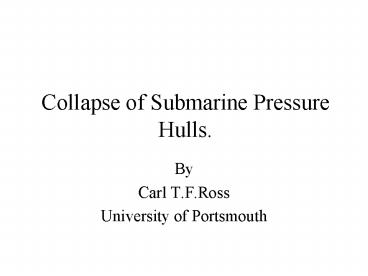Collapse of Submarine Pressure Hulls' - PowerPoint PPT Presentation
1 / 29
Title:
Collapse of Submarine Pressure Hulls'
Description:
of the Earth's surface is covered by water. ... Britain's First Nuclear-Powered Submarine -HMS DREADNOUGHT. Auguste Piccard's Trieste ... – PowerPoint PPT presentation
Number of Views:600
Avg rating:3.0/5.0
Title: Collapse of Submarine Pressure Hulls'
1
Collapse of Submarine Pressure Hulls.
- By
- Carl T.F.Ross
- University of Portsmouth
2
THE OCEANS
- ¾ of the Earths surface is covered by water.
- The Earths surface covered by water is over 10
times larger than the surface area of the Moon ! - The greatest depth of the oceans is found in the
Marianas Trench this is 11.52 km (7.16 miles)
deep. - The Marianas Trench is some 30 deeper than the
height of Mount Everest !
3
MILITARY USE OF THE OCEANS
- The oceans have great military value.
- Missile launching platforms are likely to be
placed on the ocean bottoms. - Radar does not work underwater.
- Heat seeking missiles do not work underwater.
- Satellite spy cameras are ineffective when a
submarine dives very deep into the oceans.
4
OCEAN RESOURCES
- Methane deposits in the form of hydrates have
been found at water depths of 2 miles (3.2 km)
and more. - Off the coasts of the USA, 30 gas fields have
been found. - In one gas field alone, it is believed that
there is sufficient gas to satisfy the USAs
needs for 105 years, based on their 1996
consumption rate. - Deposits of precious metal and minerals have also
been found on the ocean bottoms.
5
OCEAN PRESSURES
- At the bottom of the Marianas Trench, the
pressure is about 1158 bar (16,800psi). - Currently, a large submarine can only dive to a
depth of about 400m (1310 ft). - The construction of a large submarine pressure
hull for very large depths is not easy.
6
Shell instability an undesirable mode of
failure.
7
Buckling of a circular cylinder under an internal
vacuum by shell instability.
8
Axisymmetric yield, where the pressure hull
implodes inwardly, keeping its circular form.
9
To avoid shell instability, and improve the
structural efficiency of pressure hulls, the
vessels are usually ring-stiffened.
10
If the ring-stiffeners are not strong enough, the
vessels can buckle bodily through general
instability.
11
HISTORY OF SUBMARINES
12
The First Submarine, built by Alexander the
Great, was called Colimpha, (356-323 BC).
13
An Idea by William Bourne (1578) Not Built
14
A Cartoon of Drebbels (a Dutchman) invention
built between 1620-1624 in London.
15
Bushnells TURTLE, built to fight the British in
Americas War of Independence.
16
The HOLLAND 1, built by John Holland an
Irish-American school teacher at the end of the
19th century.
17
Britains First Nuclear-Powered Submarine -HMS
DREADNOUGHT
18
Auguste Piccards Trieste
- On 23rd January 1960, Piccard conquered the
Marianas Trench with his submarine the Trieste
1. - Its pressure hull was a thick-walled spherical
shell of 6ft diameter and 6 ins thick. - It was made of high-tensile steel
- The pressure hull had no reserve buoyancy and to
give it reserve buoyancy, it required a large
float filled with gasoline, so that it could
resurface when required.
19
The Trieste 1.
20
Jacques Piccard Lt Donald Walsh (US Navy),
inside the Trieste 1, prior to making their
record breaking dive.
21
Underwater Methane Deposits.
- Many eminent scientists believe that there are 10
000 billion tonnes of methane buried under the
sea floors in the oceans deep. - Much of this methane is frozen.
- If this methane is distributed equally among all
people on Earth, each one of us will get a 1670
tonne chunk of methane, which on current UK
prices will be worth about 1,250,000 per person!
22
Underwater Methane Deposits.
- Many eminent scientists believe that the
temperature of the oceans has increased by about
0.5 to 1.0 degree Celsius, since 1960. - If global warming continues the seas will
continue to warm up. - If the temperatures of the seas gets sufficiently
high the frozen Methane can evaporate and catch
alight. - A gas field that catches alight can burn for
about 100 years or more!
23
Underwater Methane Deposits.
- Thus, it will be necessary to use the underwater
methane to prevent it from catching alight. - The methane can be collected by drilling a hole
into the reservoir containing methane gas and
sucking the gas out, as shown by the next slide
(Blake Ridge, USA). - This will cause the pressure to fall in the area
where it is frozen and cause the frozen methane
to vaporize from this compartment into the
reservoir immediately below. - The process can be repeated until all the frozen
methane from the compartment above has
eventually vaporized into the reservoir below.
24
Methane Collection (mbsfmetres below sea floor).
25
The map shows that the USA Japan are searching
for stores of the deep sea gas but not Europe!
26
Carbon dioxide burial can also take place in the
deep oceans (mbsfmetres below sea floor).
27
Underwater drilling rig for methane retrieval
carbon dioxide burial.
28
CONCLUSIONS
- It is likely that in the future many submarine
pressure hulls will be constructed in man-made
materials, such as glass, boron and carbon fibres
and ceramic and metal-matrix composites. - Submarines constructed in man-made fibres will
lend themselves to be readily constructed in the
novel forms described here.
29
REFERENCES
- Ross, C.T.F Pressure Vessels External Pressure
Technology, Horwood Publishing, Chichester,
2001. ISBN 1-898563-74-8. - http//homepage.ntlworld.com/carl.ross/page3.htm
- Email carl.ross_at_ntlworld.com































